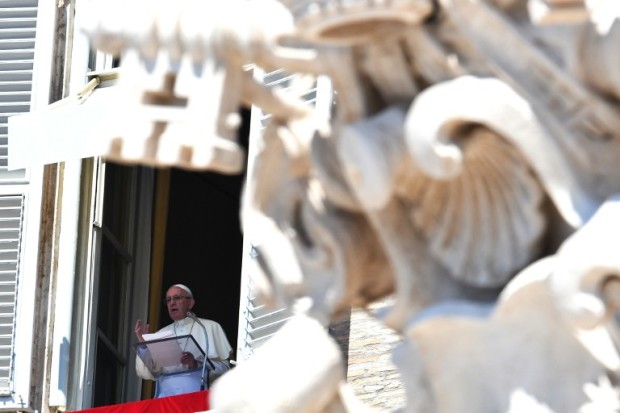
Pope Francis delivers his message to pilgrims gathered in St. Peter’s square, during his Sunday Angelus prayer at the Vatican on August 28, 2016. AFP
Pope Francis said Sunday he wanted to visit the quake-hit villages of central Italy, as survivors and rescue workers dug in for the long haul with colder weather approaching.
Speaking to worshippers in St Peter’s Square in Rome, Francis said he wanted to visit those hit by Wednesday’s deadly earthquake which brought devastation to a string of mountain villages in a remote area straddling the Umbria, Marche and Lazio regions.
“As soon as possible, I hope to come and see you, to bring you the comfort of faith, the tenderness of a father and a brother,” he said.
Nearly 300 people died in the quake and hundreds more were injured, and although rescue efforts were winding down, officials warned it was feasible there are still a dozen or so bodies under the rubble.
With hopes of finding anyone else still alive fading fast, rescue workers and survivors were turning their attention to the future as temperatures start to fall.
“We’re getting ready for winter. Given what’s happened in other quakes, we’re going to spend winter here,” said Emidio Chiappini from the devastated village of Sant’Angelo.
The government has pledged to support immediate reconstruction and Chiappini said he hoped authorities would send pre-fabricated housing to stave off the frost that will soon descend on the mountainous region.
The Italian government has freed up around 60 million euros ($67 million) in immediate aid, which will be bolstered by approximately 10 million euros in donations.
“Basically, we know we’re going to be here for three or four months. That’s not official, but we have got the equipment for that,” said a volunteer for the civil protection agency who gave his name as Nicola.
The government is reportedly poised to name a special commissioner to oversee the huge reconstruction operation, which is being hampered by aftershocks, with two more, measuring 3.7 and 4.4, hitting the region on Sunday afternoon.
Since the pre-dawn quake on Wednesday, residents’ nerves have been rattled by more than 1,800 aftershocks.
Workmanship under scrutiny
With the immediate grief fading, the focus was switching to how such damage could have been wrought in an area so close (50 kilometers/32 miles) to L’Aquila, which was hit by a 2009 earthquake in which more than 300 people perished.
Back then, the civil protection agency had to care for some 65,000 people. Nine months later, 10,000 of them were still living in temporary accommodation.
By comparison, there are only 5,000 permanent residents living in the areas affected by Wednesday’s earthquake.
Prosecutor Giuseppe Saieva has indicated that property owners who commissioned building work suspected of being sub-standard could be held responsible for contributing to the quake’s deadly impact.
“If the buildings had been constructed as they are in Japan they wouldn’t have collapsed,” he told La Repubblica daily.
“If it emerges that individuals cut corners, they will be pursued and those that have made mistakes will pay a price,” the prosecutor said.
Corruption concerns
On Monday, experts were expected to visit all the local schools to decide if any were still safe and to draw up plans for alternatives in time for the start of the new term in mid-September.
“The lessons from Aquila in 2009 have not been learned,” fumed Adriana Cavaglia, a member of the national council of geologists as she surveyed the ruins in Sant’Angelo.
Not far away, property developer Sergio Evangelista is happy to be able to finally go back and sleep in his own home, which was built in line with the building regulations and was almost untouched.
The village church, however, which was inaugurated on August 13 following a clumsy renovation, collapsed.
Atemio Scienzo, a craftsman who survived the quake, said he was concerned that endemic corruption could hamper reconstruction efforts.
“After the emergency comes the period of reconstruction and that’s the important bit. It has to happen quickly and the funds have to arrive,” he said.
“If half of it gets lost en route, as often happens, there will be a problem.”
Meanwhile, demonstrations of solidarity continued across the country with thousands turning out in Turin to eat pasta all’amatriciana, the famous dish which originated in Amatrice, with the proceeds of the meal to be sent to the survivors.
RELATED STORIES
Magnitude 6.1 quake rattles Rome and central Italy
Italy mourns quake dead as hope for survivors wanes
Rescuers search for survivors in Italy quake that killed 247
Cardinal Tagle calls for prayers for Italy quake victims
Italian president visits quake town, thanks rescue workers